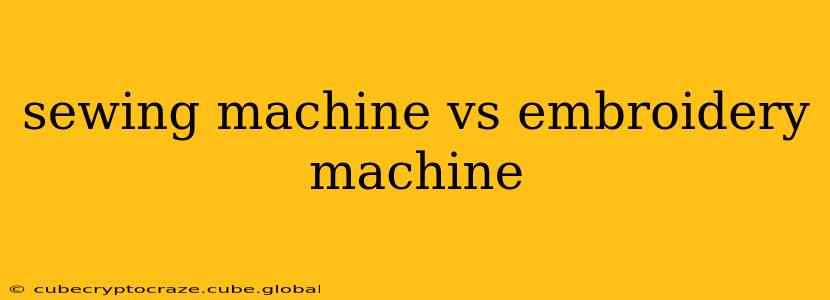Choosing between a sewing machine and an embroidery machine can be confusing, especially for beginners. Both machines manipulate fabric with needles and thread, but their functions and capabilities differ significantly. This comprehensive guide will clarify the distinctions, helping you determine which machine best suits your needs and budget.
What is a Sewing Machine?
A sewing machine is a fundamental tool for various sewing tasks, from mending clothes to creating intricate garments. Its primary function is to stitch fabric together using a straight stitch or a variety of other basic stitch types. While some sewing machines offer decorative stitches, their main purpose is functional sewing.
Capabilities of a Sewing Machine:
- Stitching fabrics together: This is the core function, enabling projects from simple repairs to complex garments.
- Creating seams: Sewing machines efficiently create strong and consistent seams.
- Hemming garments: Neatly finishing edges and hems is a common task.
- Adding embellishments: Some models offer decorative stitches for added flair, but this is often limited.
What is an Embroidery Machine?
An embroidery machine is specialized for creating intricate designs on fabric using thread. While some basic sewing functions might be included, its primary focus is artistic embroidery. These machines utilize digitized patterns to stitch complex designs with precision and speed.
Capabilities of an Embroidery Machine:
- Creating detailed embroidery designs: From monograms to elaborate artwork, embroidery machines excel at detailed work.
- Customizable designs: Many allow importing and editing digital designs.
- Multiple embroidery types: A wide range of stitch types and effects are possible.
- Automatic hooping and threading: Some models streamline the embroidery process.
Sewing Machine vs. Embroidery Machine: Key Differences
| Feature | Sewing Machine | Embroidery Machine |
|---|---|---|
| Primary Function | Stitching fabrics together | Creating embroidery designs |
| Stitch Types | Limited range, primarily functional stitches | Wide variety, including intricate decorative stitches |
| Design Input | Manual stitch selection | Digitized designs, often via computer software |
| Speed | Generally faster for straight stitching | Slower, but capable of intricate detailed work |
| Cost | Generally less expensive | Significantly more expensive |
| Complexity | Easier to learn and operate | Steeper learning curve, more complex to master |
What kind of sewing machine do I need for embroidery?
While a standard sewing machine can't create intricate embroidery, many modern sewing machines offer some embroidery capabilities. These typically include a limited selection of decorative stitches. However, for complex designs or large-scale embroidery projects, a dedicated embroidery machine is necessary. If you only need basic decorative stitching, a sewing machine with a wide variety of stitches might suffice.
Can I do embroidery on a sewing machine?
You can do some simple embroidery on a sewing machine, using free-motion stitching or by employing specialized embroidery feet. However, the results will be far less intricate and precise than what an embroidery machine can achieve. Free-motion embroidery allows for some creative freedom, but the design limitations are substantial.
What is the difference between a sewing and embroidery machine?
The core difference lies in their primary function. A sewing machine's purpose is to join fabric; an embroidery machine's is to create embroidered designs. While some overlap exists (e.g., some sewing machines offer simple decorative stitches), the capabilities and complexity are vastly different. Embroidery machines offer significantly more control and precision for creating detailed designs.
Which machine is right for me?
The best choice depends on your sewing goals. If you primarily need to stitch fabrics together for clothing, alterations, or home décor projects, a sewing machine is sufficient. If creating detailed embroidery designs is your focus, an embroidery machine is the better investment. Consider your budget, skill level, and the types of projects you plan to undertake. For those wanting to do both, a combination machine (sewing and embroidery) might be a good option, although these typically compromise on the capabilities of each function compared to dedicated machines.
